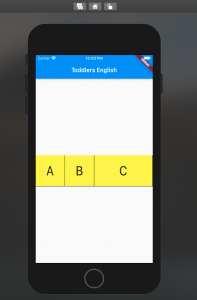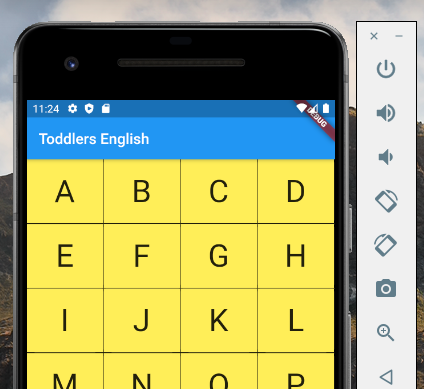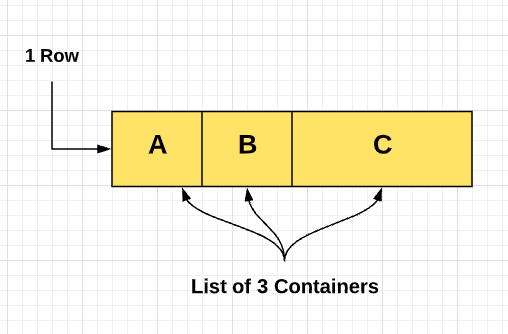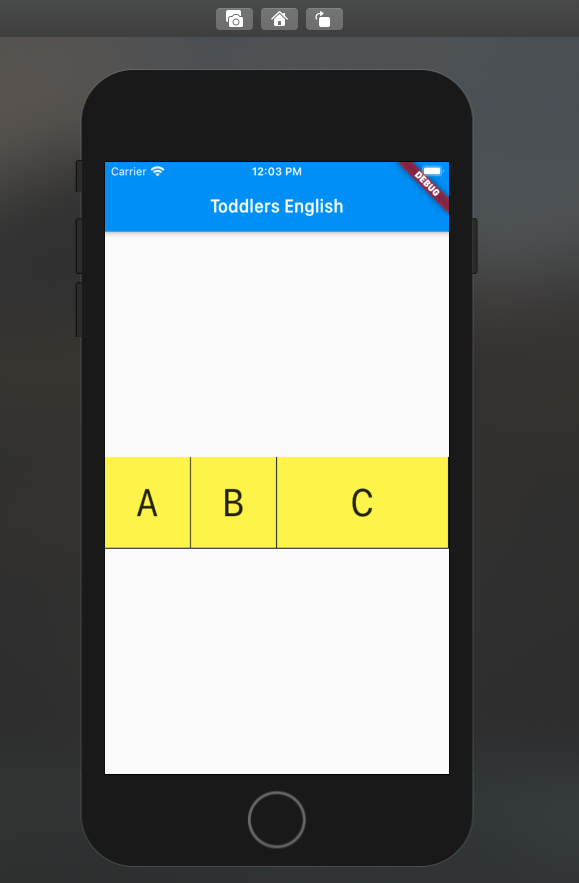
In this post, you will learn about how to use Flexible Widget to ensure equal spacing for children of Row.
Flexible is a widget that controls how a child of a Row, Column, or Flex flexes. In this post, we will see how to use a Flexible widget to control the width of the children’s widget contained in the Row widget. Look at each of the rows in the app below consisting of 4 letters of the English Alphabet.

In case we don’t use a Flexible widget, we may have to assign the width of each of the containers (represented using commented cell width in the code below. However, using a Flexible widget, there is no need for the cell width of each Container represented using a Container widget. As the width of each of the container widgets is the same, one may not be required to use flex property. Alternatively, one could use flex:1 as well. You could get to see the full code in the earlier post, Flutter Row Concepts with Code Example.
Row(
children: List.generate(alphabets[6].length, (index) {
return Flexible(
child: Container(
height: cellheight,
//width: cellwidth
alignment: cellalignment,
decoration: const BoxDecoration(
color: Color(0xFFFFEE58),
border: Border(
right: BorderSide(width: 1.0, color: Color(0xFFFF000000)),
bottom: BorderSide(width: 1.0, color: Color(0xFFFF000000)),
)),
child: Text(
alphabets[6][index],
textScaleFactor: tsFactor,
)),
);
}),
),
More Flexible Widget Example with Row Widget
For the row that looks like the following, the code will look such as the following. Make a note of how flex: 2 for third container widget consisting of C as Text Widget. The first two Flexible widgets has the value of flex property as 1.

Row(children: [
Flexible(
flex: 1,
child: Container(
height: 100,
alignment: Alignment.center,
decoration: const BoxDecoration(
color: Color(0xFFFFEE58),
border: Border(
right: BorderSide(
width: 1.0, color: Color(0xFFFF000000)),
bottom: BorderSide(
width: 1.0, color: Color(0xFFFF000000)),
)),
child: Text('A', textScaleFactor: 3.0)),
),
Flexible(
flex: 1,
child: Container(
height: 100,
alignment: Alignment.center,
decoration: const BoxDecoration(
color: Color(0xFFFFEE58),
border: Border(
right: BorderSide(
width: 1.0, color: Color(0xFFFF000000)),
bottom: BorderSide(
width: 1.0, color: Color(0xFFFF000000)),
)),
child: Text('B', textScaleFactor: 3.0)),
),
Flexible(
flex: 2,
child: Container(
height: 100,
alignment: Alignment.center,
decoration: const BoxDecoration(
color: Color(0xFFFFEE58),
border: Border(
right: BorderSide(
width: 1.0, color: Color(0xFFFF000000)),
bottom: BorderSide(
width: 1.0, color: Color(0xFFFF000000)),
)),
child: Text('C', textScaleFactor: 3.0)),
),
]);
The entire code of the app would look like the following:
void main() {
runApp(MyApp());
}
class MyApp extends StatelessWidget {
@override
Widget build(BuildContext context) {
return MaterialApp(
title: 'Learn English',
home: Scaffold(
appBar: AppBar(
title: Text('Toddler\s English'),
),
body: Center(
child: AlphabetWidget(),
),
));
}
}
class AlphabetWidget extends StatelessWidget {
@override
Widget build(BuildContext context) {
return Row(children: [
Flexible(
flex: 1,
child: Container(
height: 100,
alignment: Alignment.center,
decoration: const BoxDecoration(
color: Color(0xFFFFEE58),
border: Border(
right: BorderSide(
width: 1.0, color: Color(0xFFFF000000)),
bottom: BorderSide(
width: 1.0, color: Color(0xFFFF000000)),
)),
child: Text('A', textScaleFactor: 3.0)),
),
Flexible(
flex: 1,
child: Container(
height: 100,
alignment: Alignment.center,
decoration: const BoxDecoration(
color: Color(0xFFFFEE58),
border: Border(
right: BorderSide(
width: 1.0, color: Color(0xFFFF000000)),
bottom: BorderSide(
width: 1.0, color: Color(0xFFFF000000)),
)),
child: Text('B', textScaleFactor: 3.0)),
),
Flexible(
flex: 2,
child: Container(
height: 100,
alignment: Alignment.center,
decoration: const BoxDecoration(
color: Color(0xFFFFEE58),
border: Border(
right: BorderSide(
width: 1.0, color: Color(0xFFFF000000)),
bottom: BorderSide(
width: 1.0, color: Color(0xFFFF000000)),
)),
child: Text('C', textScaleFactor: 3.0)),
),
]);
}
}
When deployed on iOS phone simulator, the above code would get displayed as the following:

- Coefficient of Variation in Regression Modelling: Example - November 9, 2025
- Chunking Strategies for RAG with Examples - November 2, 2025
- RAG Pipeline: 6 Steps for Creating Naive RAG App - November 1, 2025
I found it very helpful. However the differences are not too understandable for me